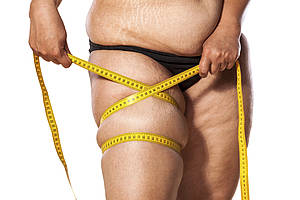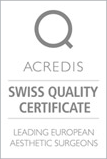Diet-resistant subcutaneous fat

The fat distribution of the human body is established early in life. Factors that determine the silhouette of the body include genetic heritage, gender, physical activity and calorie intake. Genetics determine the number and individual distribution of fat cells, which remain fixed following puberty and do not change much thereafter. Diet or exercise can lead to an increase or decrease of the fat mass within each fat cell, but have little influence on the number or distribution of the fat cells. Thus, the total number of fat cells of an individual remains constant for life, apart from an excessive calorie intake; generally, you cannot lose a fat cell once it has been created.
For example, if a person is genetically predisposed to have many fat cells in the hip area and few in the upper body, he or she will have more fat on the hips than their upper body for their entire life. Even intensive dieting or fitness programs will have little effect on this relative fat distribution; you can lose weight overall, but still retain curves on the hips, waist, belly or the outside of the thighs. Such stubborn fat deposits, that sometimes first appear only after the age of 30 or following pregnancy, are known as diet- or exercise-resistant fat deposits.

With a reduction in the amount of body fat the fat cells do not disappear. They continue to exist as memory cells and can easily be refilled. This is the case when the diet is relaxed or physical activity is given up. Liposuction aims to permanently remove the fat tissue, because the operation reduces the number of fat cells of the body. Thus, the supply of fat cells that can actually store fat is reduced.
The primary goal of liposuction is the reduction of isolated fat deposits in body-conscious, physically active individuals with normal or only slightly elevated body weight. Your problem is the inability to further affect one or more areas of the body through diet or exercise. For women, the isolated fat deposits are mostly in the region of the chin, upper and lower abdomen, hips, inner and outer thighs (“saddle bags”), knees and calves. For men, the regions are mostly the abdomen, the waist (”love handles”), breasts and inner thighs.

Even in overweight people, these annoying problem areas can be treated with permanent improvement to proportions. Although a guarantee of weight reduction is not possible, a further overall weight loss is often observed with these patients, following removal of circumscribing fat deposits. Research is currently being conducted as to how much of this is based on psychological change (increased motivation to do something for the body through diet modification), hormonal changes or reduction of fat storage.

